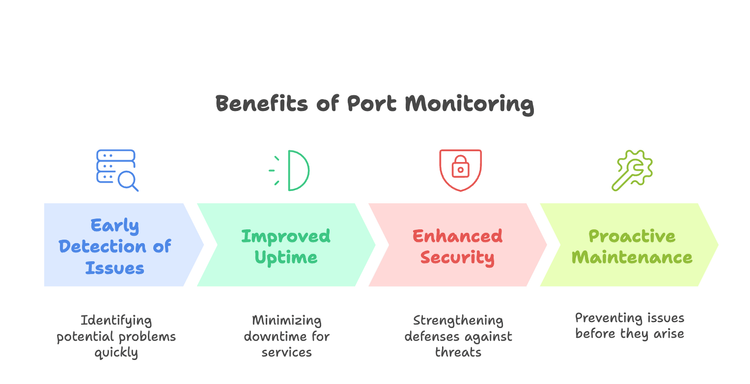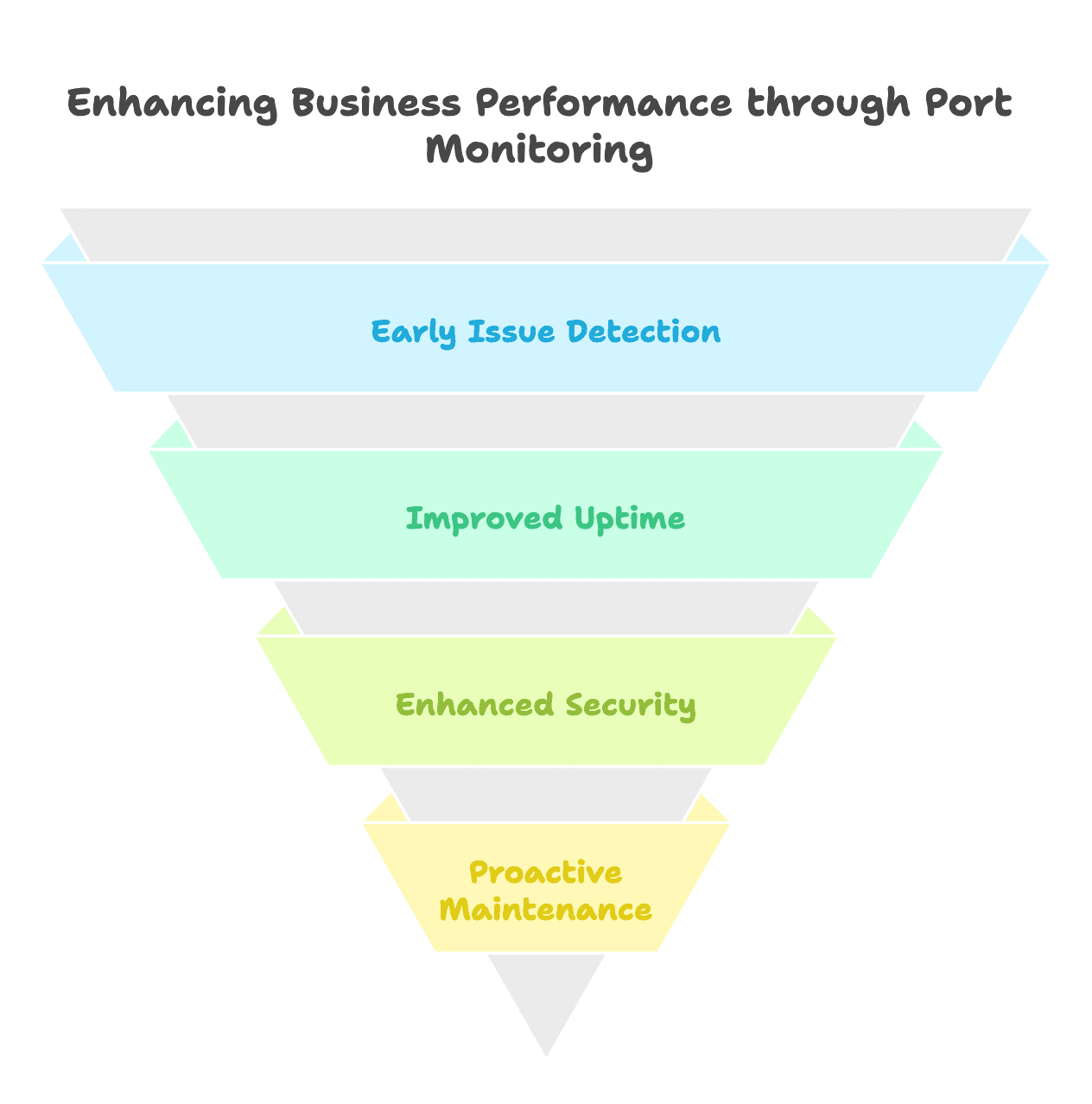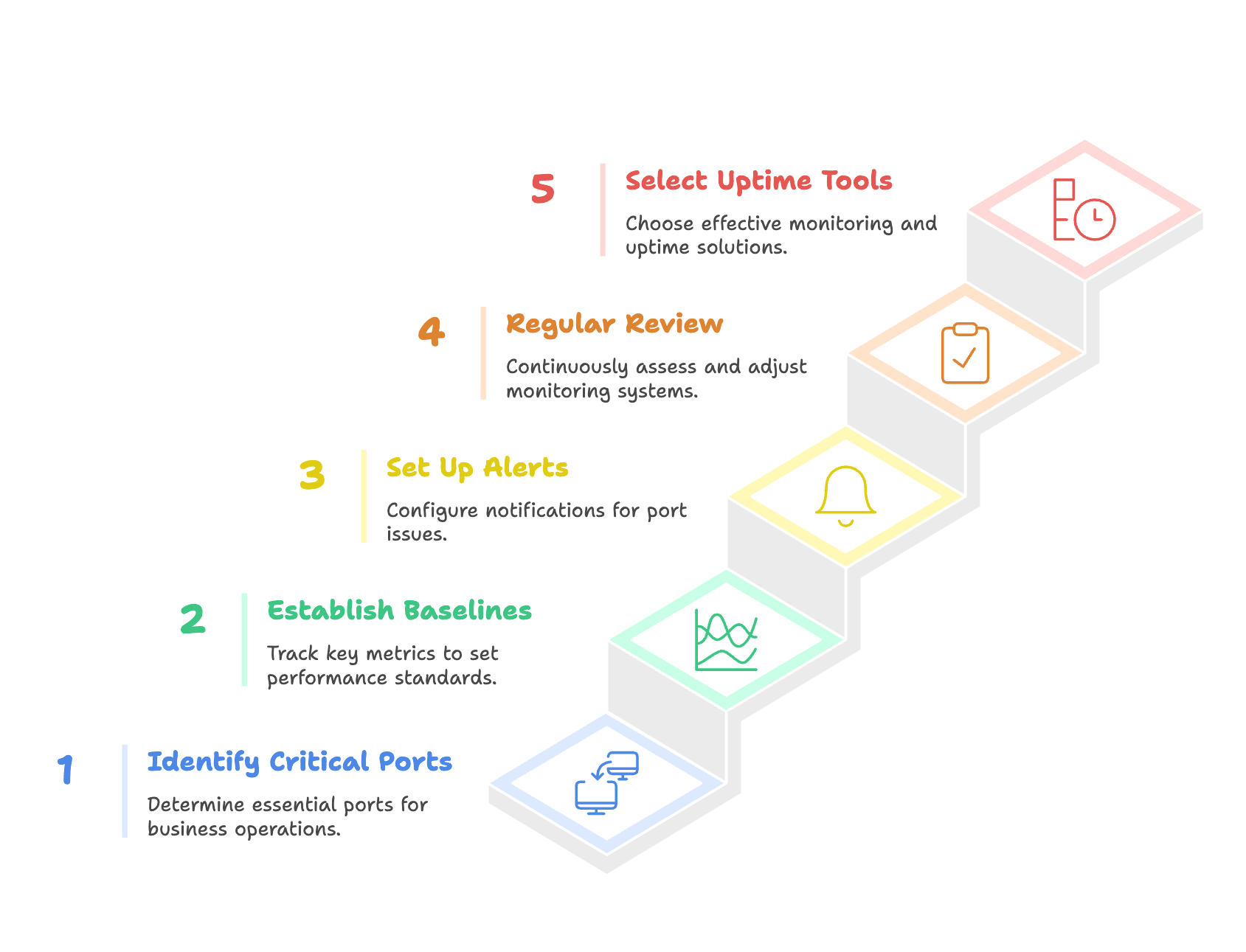Best Practices for Server Monitoring: Ensuring Uptime through Port Monitoring

Imagine your website suddenly goes down. Customers can't access your services, orders can't be processed, and your business suffers. This scenario highlights the critical importance of server monitoring and uptime tools for businesses of all sizes.
To ensure uninterrupted service availability, businesses must implement robust server uptime monitoring practices. One of the most effective port monitoring techniques is continuous assessment of server ports.
1. Understanding Port Monitoring
Visualize your server as a physical structure. Ports function as the doors and windows that facilitate the flow of communication. Each port on your server is assigned a unique numerical identifier. Port monitoring involves the continuous assessment of these ports to ensure they are open and functioning as intended.
How it works:
Port monitoring tools systematically verify that each port on your server is operational and responding correctly. If a port is closed or not responding, this may indicate a problem with the server, the application running on the server, or the network.
2. The Importance of Port Monitoring

The port monitoring benefits are substantial and can directly impact your business performance:
Early Detection of Issues
Effective port monitoring can facilitate the early detection of potential issues, including network outages, application malfunctions, and security breaches. For instance, if a web server's port is closed, customers will be unable to access your website.
Improved Uptime
By swiftly identifying and resolving issues, you can significantly minimize downtime and maintain continuous service availability for your customers. This is critical for ensuring customer satisfaction and preventing revenue loss.
Enhanced Security
Port monitoring assists in identifying unauthorized access attempts or malicious activities targeting specific ports. Early detection of suspicious activity allows you to take steps to mitigate risks and protect your systems.
Proactive Maintenance
Advanced port monitoring techniques enable the proactive identification and resolution of potential problems before they escalate. This preventative approach helps avoid unexpected downtime and reduces the need for costly emergency interventions.
3. Best Practices for Port Monitoring

To effectively monitor your server ports, the following best practices should be followed:
Identify Critical Ports
Determine which ports are essential for your business operations. This may include ports for web servers, databases, email servers, and other key applications. It's important to have a clear understanding of which ports are most important.
Establish Baselines
Using quality server monitoring solutions, track key metrics such as response times, throughput, and error rates to establish baseline performance levels for each port. Any deviations from these baselines may signal potential problems that require attention.
Set Up Alerts
Configure your monitoring system to trigger alerts when critical ports are closed, unresponsive, or exhibiting atypical behavior. These alerts can be sent via email, SMS, or in-app notifications, to ensure prompt notification of any issue.
Regular Review and Adjustments
Regularly assess your monitoring configuration and adjust it as needed to reflect changes in your infrastructure or business requirements. This ensures that the monitoring system continues to be effective and remains relevant as your business evolves.
Selecting the Right Uptime Tools
To effectively implement port monitoring, it is essential to have the right tools. When choosing server monitoring and uptime tools, ensure they offer:
- Real-time Monitoring Capabilities: This ensures you are constantly aware of the status of your server ports, for faster identification of potential problems.
- Port Monitoring Functionality: The tool should specifically support robust port monitoring techniques, and offer detailed information regarding port status and performance. This facilitates thorough assessments.
- Customizable Alert Configurations: The tool should enable you to customize alerts to meet specific needs, ensuring that notifications are received for the most critical issues.
- User-Friendly Interface: The tool should have an intuitive interface that allows you to easily set up, manage, and analyze the monitoring data. This reduces complexity for your team.
- Scalability: The tool should be able to accommodate the growing needs of your business and its future requirements.
Bubobot offers comprehensive server uptime monitoring that can substantially improve your port monitoring strategy.
- Real-Time, Unlimited Monitoring: Bubobot provides 24/7 monitoring of your server ports, offering continuous visibility into their health and performance.
- Smart Alert System: Bubobot's customizable alert system prioritizes critical issues and sends targeted notifications, allowing your team to respond efficiently.
- Advanced Port Monitoring Techniques: With sophisticated monitoring protocols, Bubobot can detect subtle issues before they become major problems.
- Scalable Solutions: With adaptable pricing and robust functionality, Bubobot can easily scale as your business grows, ensuring you always have the necessary monitoring coverage.
By utilizing a tool like Bubobot and implementing effective port monitoring practices, you can improve your server uptime, reduce downtime, and enhance the reliability of your IT infrastructure.
5. Conclusion
Server uptime is essential for maintaining business continuity. Through effective port monitoring techniques and the right uptime tools, you can proactively identify and address potential issues, minimize downtime, and ensure that your business operations run smoothly.
For DevOps professionals and IT administrators managing critical systems, implementing robust server monitoring with comprehensive port monitoring capabilities isn't just a technical requirement—it's a business necessity.